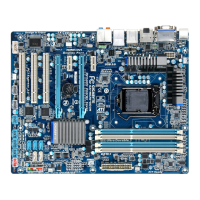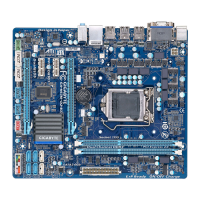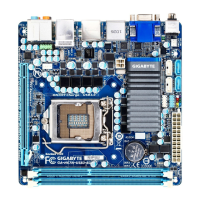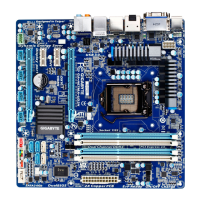Do you have a question about the Gigabyte GA-H67A-USB3-B3 and is the answer not in the manual?
Safety and handling guidelines before installation.
Lists technical details and features of the motherboard.
Guide for installing the processor and its cooler.
Instructions for installing RAM modules.
Steps for adding PCI/PCIe cards to the motherboard.
Identifies and describes external I/O ports.
Identifies and describes internal headers and connectors.
Describes boot screens and function keys for BIOS access.
Overview of BIOS navigation and function key usage.
For advanced CPU and memory tuning.
For system date, time, and hard drive configuration.
For boot order and other system feature settings.
For configuring onboard devices like SATA, USB, and LAN.
For configuring system power saving options.
For monitoring system temperatures, voltages, and fan speeds.
Restores stable BIOS settings for system operation.
Restores optimal BIOS settings for system performance.
For securing access to BIOS settings.
Saves BIOS configuration changes and exits the setup utility.
Exits BIOS setup without saving any changes.
Crucial drivers for motherboard stability and performance.
Install GIGABYTE utilities and other bundled software.
Provides content descriptions for the driver disk.
Information for GIGABYTE's global support offices.
Displays basic information about the computer system.
Links to the latest BIOS, drivers, and applications.
Access to recently developed GIGABYTE utilities.
Utility for system backup and restoration.
Method for updating BIOS using a USB flash drive.
Method for updating BIOS from within Windows.
Software for system tuning and overclocking.
Technology for optimizing system power savings.
Tool for easy data sharing over a network.
Suite of utilities for system management and performance.
Feature for system power saving controlled by Bluetooth.
Utility for configuring RAID arrays.
Utility for system overclocking via Internet connection.
Steps for setting up SATA controllers and RAID.
Guide for setting up audio jacks and features.
Solutions for common system startup problems.
| Form Factor | ATX |
|---|---|
| Socket | LGA 1155 |
| Chipset | Intel H67 |
| Memory Type | DDR3 |
| Maximum Memory | 32 GB |
| SATA 6Gb/s | 2 |
| SATA 3Gb/s | 4 |
| USB 3.0 Ports | 2 |
| Memory Speed | 1333 MHz |
| Audio | Realtek ALC889 |
| LAN | 10/100/1000 Mbps |
| Video Outputs | HDMI, DVI |
| Memory Slots | 4 x DIMM |
| Expansion Slots | 1 x PCI Express x16, 2 x PCI Express x1 |











